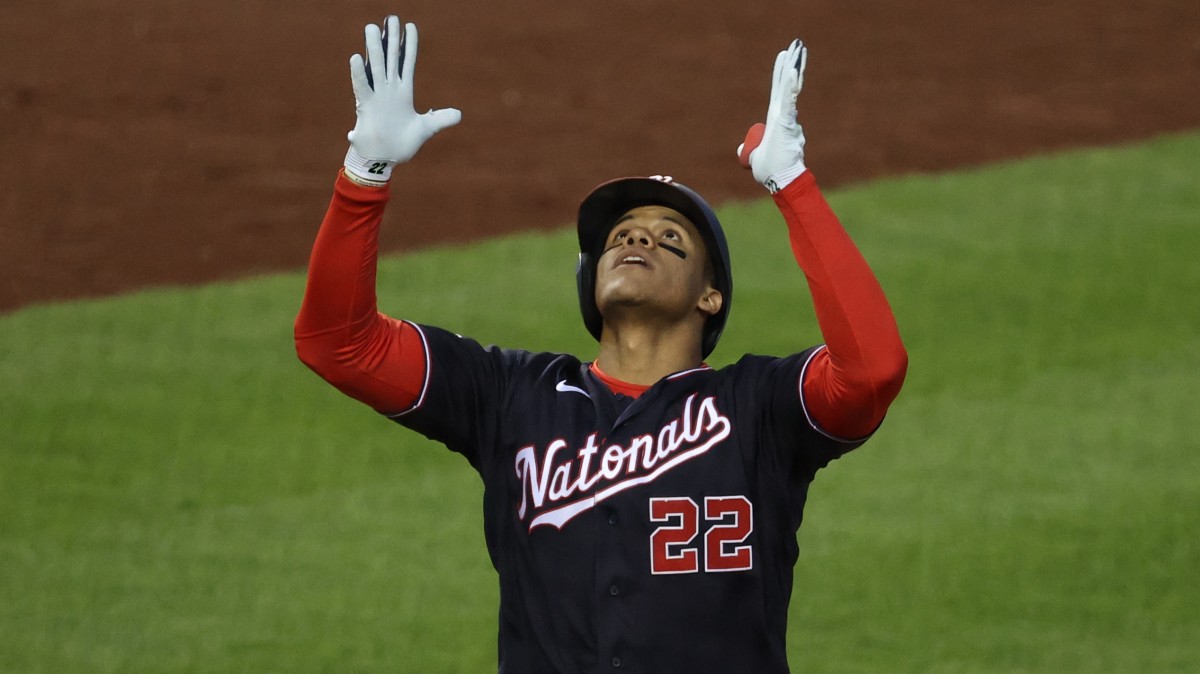Will Juan Soto Be MLB's First $500 Million Player?
With their 14-year, $340 million, franchise-altering contract extension to star shortstop Fernando Tatis Jr., the Padres announced to the baseball world their intentions at perennial contention. But beyond the rejoicing taking place in San Diego at keeping the future face of the league in beautiful brown pinstripes, the conversation almost immediately shifted to the game’s other 22-year-old phenom: What does this mean for Juan Soto?
Predictably, demands for the Nationals to pony up big money for Soto began in earnest. Speculation abounded for how much money it would take for Soto to sign a deal similar to Tatis’s, with some believing that $340 million “isn’t even close” to how much Washington would have to offer to get a deal done.
Regardless of what the Nationals decide to do, the question for Soto is whether or not he’ll end up being baseball’s first half-a-billion-dollar player. That number sounds audacious, but if we put Soto’s historical start to his career in context with other factors that would impact his earning power, then $500 million begins to appear within his reach.
First, a look at Soto’s historical peers shows just how truly special he’s been. Through his age-21 season, he’s posted an OPS+ of 151, which ranks 11th highest in baseball history among players of the same age (minimum 500 plate appearances). He’s ahead of inner-circle Hall of Famers Mickey Mantle, Ken Griffey Jr., Frank Robinson and Mel Ott. He also outpaces some of his contemporaries in that category, like Ronald Acuña Jr., Cody Bellinger, Giancarlo Stanton and Carlos Correa—not bad for a guy who made just 35 minor league plate appearances above Class A.

Soto has the fifth-best on-base percentage (.415) under the same criteria—better than Mike Trout, Albert Pujols, Stan Musial and Rickey Henderson. His OPS (.972) ranks sixth all-time—one spot ahead of Tatis and two ahead of Trout.
In a testament to how well-established his reputation is at such a young age, he became the second player 21 or younger ever to lead the majors in intentional walks last season (12), and the first since Eddie Mathews in 1953. Soto’s 12 free passes are tied for the fourth most ever given to a player 21 or younger, and he was on pace to break Griffey’s record of 21 set in 1991 if he hadn’t played in a pandemic-shortened 60-game season.
A look at player similarity scores from Baseball-Reference drives the larger point home: Soto is on track to be one of the greatest hitters of his generation. His most similar player is Frank Robinson, the only player to win an MVP award in both leagues. Six of Soto’s 10 most similar players are Hall of Famers. Among the other four are Trout and Acuña.
Trout, Acuña and Tatis all share something in common: They signed nine-figure extensions with their original franchises that kept them under team control for at least a decade. It’s possible that Soto, who is repped by Scott Boras, is unlikely to go that route unless Washington comes with a record-breaking offer.
Soto will likely reach that half-a-billion mark even if he opts against signing an extension. Tatis was projected to make around $50-60 million over three arbitration years before his extension, per Brittany Ghiroli of The Athletic. Soto will make $8.5 million in 2021, then has three more years of arbitration eligibility, so we can project low and say he’ll make at least $60 million from the Nationals from now until he reaches free agency.
When Trout signed his mega-extension in 2019, it brought the total value of his contract to 12 years, $426.5 million. Soto has not accomplished what Trout had to that point, but he’s on his way. And given Boras’s reputation for maximizing his clients’ earning potentials—plus the improved economic landscape of the league as it moves forward from a season without fans in stadiums—it’s not hard to envision Soto getting an even bigger deal when the time comes.
How this plays out will be among the most talked-about issues in Major League Baseball for the foreseeable future. What’s not a mystery, though, is that Soto—one of the greatest young players the game has ever seen—will break records when it comes time for his massive payday. It’s just a matter of which team will be the one to write the check.
